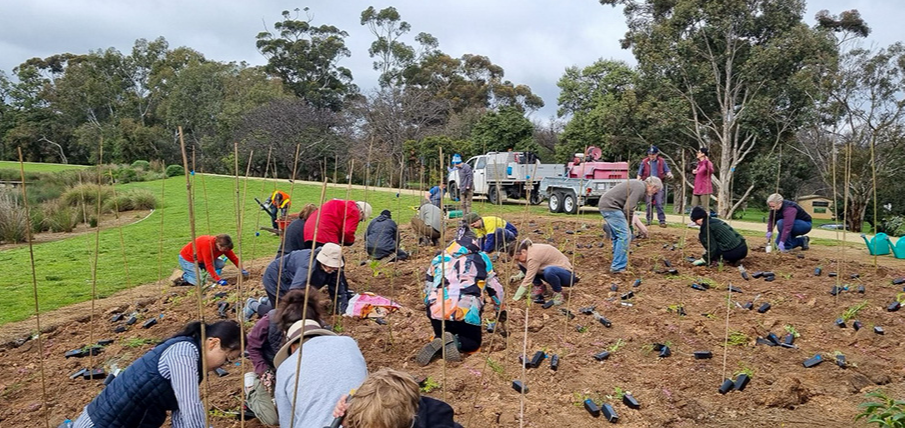SECRA's miniature forests to boost Victoria Park's biodiversity and climate resilience

The South East City Residents Association (SECRA) volunteer group, Green Pakapakanthi, a recipient of our Community Grants Program, recently established two miniature forests in Victoria Park/Pakapakanthi to boost the area's biodiversity and climate resilience.
One forest was cultivated using the Miyawaki method, a technique that involves intensive soil preparation and high-density planting. The other forest, serving as a control plot for comparison, was planted using traditional horticultural methods.
Miyawaki forests are said to grow 10 times faster, are 30 times denser, and contain 100 times more biodiversity than traditional forests. They establish quickly, require no maintenance after the first two to three years, and can be created on sites as small as 3 square meters, making them a viable solution for cities looking to rapidly build climate resilience.
Doug McEvoy, Chair of SECRA, explained, "SECRA members had become increasingly worried in recent years about the lack of trees on Victoria Park – trees that are needed to shade and protect park users during Adelaide’s increasingly hotter, longer summers. And we were also concerned about how little understory there is for smaller birds."
Pictures: With support from our Community Grants program, South East City Residents Association (SECRA)’s Green Pakapakanthi volunteer group planted two mini forests in Victoria Park/Pakapakanthi.
The Miyawaki method mimics the natural regeneration of forests in the absence of human intervention. It uses only native species that would naturally occur in the area, based on specific climate conditions. These indigenous species have adapted over thousands of years to their local environments, creating ecosystems that not only restore biodiversity but are also more responsive to climate change.
"We learned at an international symposium run by Dr. Scott Hawken (Adelaide University, Landscape Architecture) how the community-led Miyawaki revegetation method could create rapid multispecies shrub and tree growth. It seemed like an ideal model for SECRA’s Green Pakapakanthi to deploy,” McEvoy said.
As part of this project, SECRA is experimenting by cultivating two forests of identical size using these different methods. The objective, through comparing their growth and biodiversity, is to gain a deeper understanding of the Miyawaki method's efficacy in rejuvenating natural habitats.
Picture: The area in Victoria Park/Pakapakanthi with the two new mini forests.
These plantings are adjacent to a pre-existing miniature forest, established in August 2023. Collectively, they will form a corridor and a significant concentration of endemic plants, creating a protected environment where small birds can feed, nest, and thrive.
McEvoy added, "We approached the City of Adelaide Council, who gave us the green light and provided in-kind support to help us get started. The growth of our first Miyawaki forest, planted in the Victoria Park wetland in August 2023, has been very encouraging. We think the Miyawaki tiny forest method has great potential for rapidly greening, cooling, and enhancing biodiversity not only in Victoria Park but in our parks and streets more broadly."
By comparing plant growth and biodiversity across these distinct plots, this project will provide valuable insights into the Miyawaki method’s potential for restoring native habitats in Adelaide’s parks and streets. McEvoy concluded, “However, more work and citizen science is needed to make the case. The grant from SA Power Networks will enable us to do this.”
Learn more
The SA Power Networks Community Grants program is designed to empower communities to create positive change in their local areas. The grants support activities, programs, or events that make a real impact across South Australia. Interested in learning more or registering for 2025?
Read all about our Community Grants.
Find out more about the South East City Residents Association on the SECRA website.